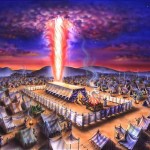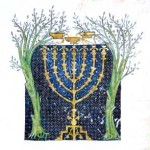Musings from Students of the Pardes Institute of Jewish Studies in Jerusalem
Posted on December 5, 2012 by Hannah Grossman
I have always loved exploring the connections between the Torah/Haftarah readings in respect to the holidays on which they are read. With Chanukah coming around the corner I saw an opportune time to delve into an analysis.
Throughout Chanukah we read Bamidbar 7:1- 8:4, chronicling the gifts of the princes of the twelve tribes at the time of the inauguration of the mishkan. Both this reading and the Haftarah from Zecharia lend more holistic insights into the meaning of the Feeestival of Liiiiights.
Beginning with Bamidbar we see a direct relationship between the date of the completion of the mishkan and Chanukah as well as the theme of individual gifts for a holy purpose.
 While construction of the mishkan was completed on the 25th of Kislev in 1312 BCE (2449 from creation), it was not assembled until the 25th of Adar when there began a training period preceding its dedication on the 1st of Nissan.
While construction of the mishkan was completed on the 25th of Kislev in 1312 BCE (2449 from creation), it was not assembled until the 25th of Adar when there began a training period preceding its dedication on the 1st of Nissan.
Our rabbis tell us that the rededication of the Temple by the Maccabees twelve centuries later on the 25th of Kislev 139 BCE (3622) was compensation for the “unmarked” day of the mishkan’s initial dedication. When we celebrate Chanukah today we are not only remembering the rededication of the Temple during the Maccabean revolt. We are also connecting deeper into our past, commemorating the Tabernacle which accompanied us through the desert and marked one of the first dedication ceremonies of the Jewish people. We light the channukiah as a reminder not only of the Chanukah miracle but of the light that shone in the mishkan 1200 years prior.
The Torah readings further relate to Chanukah through the individual, yet identical gifts brought to the mishkan. Just as each tribe had its own day to bring its offering, so too, we light one candle each night of Chanukah. Doing so we fulfill the obligation for each Jewish household to contribute to the cumulative light of the Jewish people. It is not one central body displaying the dedication on behalf of the Jewish people- it’s every Jewish person doing it on behalf of himself, affirming his dedication to the larger community and what it stands for.
 Lastly, the Haftarah from Zechariah (2:14-4:7) ends with Zechariah’s vision of a menorah followed by an angel’s interpretation: “This is the word of the Lord to Zerubbabel (descendent of King David), ‘Not by military force and not by physical strength, but by My spirit,’ says the Lord of Hosts.” (“Lo v’chayil v’lo v’koach ki im b’ruchi”). This is widely understood to be in regards to Zerubbabel’s descendent, the Moshiach, who will not use physical force in carrying out his task. However, in light of the holiday, this is interpreted as a message of how Chanukah is not about a military victory, but of the eternal light (ner tamid), the spirit of the Jewish people and of God.
Lastly, the Haftarah from Zechariah (2:14-4:7) ends with Zechariah’s vision of a menorah followed by an angel’s interpretation: “This is the word of the Lord to Zerubbabel (descendent of King David), ‘Not by military force and not by physical strength, but by My spirit,’ says the Lord of Hosts.” (“Lo v’chayil v’lo v’koach ki im b’ruchi”). This is widely understood to be in regards to Zerubbabel’s descendent, the Moshiach, who will not use physical force in carrying out his task. However, in light of the holiday, this is interpreted as a message of how Chanukah is not about a military victory, but of the eternal light (ner tamid), the spirit of the Jewish people and of God.
As we begin this Chanukah I hope that we can all find purpose as individuals making up an ancient, living community, spreading that same light which accompanied us in the desert and shines out our windows today.
Happy Chanukah!!!!
-Hannah G.